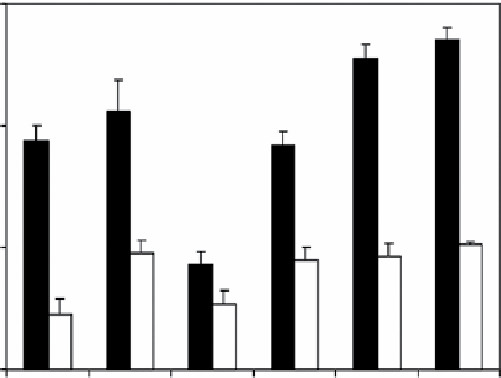Environmental Engineering Reference
In-Depth Information
9.0E+05
Ketoprofen
Ibuprofen
6.0E+05
3.0E+05
0.0E+00
figure 14.6
Effect of sorbent type on extraction efficiency (EE) of μ-sPE. Reproduced with permission from Ref. [18]. © ACs.
metallic compounds on FUls has shown higher extraction efficiencies for lead in water, cobalt in wheat flour, as well as inor-
ganic and organic cadmium and lead during metal speciation [4, 7-9].
14.4.2
micro solid-phase extraction
To achieve high enrichment while reducing the sorbent and solvent amount, μ-sPE has been developed recently. The objective
was to approach the size and convenience of sPME but retain the lower detection limits offered by sPE. These techniques
attempt to miniaturize conventional sPE to smaller beds and solvent volumes and offer the convenience of easier analyte
recovery and shorter sample preparation time. The small sorbent beds contain a small amount of sorbent, and high-performance
sorbent materials are required to obtain satisfactory extraction efficiencies.
A membrane-assisted μ-sPE device containing C-18 and CNTs has been reported [18]. Here the sorbent is held within a
polypropylene membrane envelope. A square (15 × 15 mm), heat-sealed polypropylene sheet membrane envelope was packed
with 6 mg of MWCNT. This μ-sPE device may be dropped into and stirred in aqueous samples. The approach is somewhat sim-
ilar to stir bar microextraction (sbME). The analytes from the sample diffuse through the membrane and are adsorbed on the
MWNT filling. After extraction, the device is removed, rinsed, dried, and dipped in organic solvents under ultrasound to desorb
the extracted species. MWNT was found to be an efficient sorbent for this new μ-sPE device and was compared to conventional
sorbents like C18, C2, Carbograph, Hayesep A, and Hayesep b. In Figure 14.6, C18 showed the highest extraction efficiency
(EE) for both compounds. CNTs were better than Carbograph and comparable with Hayesep A. However, as compared to C18,
CNTs showed lower EE. The reason was insufficient electrostatic interaction between MWNTs and target analytes [18].
A μ-sPE device consisting of a syringe where CNTs were packed and self-assembled within an attached 0.53-mm Id needle
has been reported. The device is shown in Figure 14.7. The enrichment factor (EF) and EE for self-assembled CNTs, sWNTs,
and MWNTs were compared to C-18. Table 14.3 lists these values for 2-nitrophenol, 2,6-dichloroaniline, and naphthalene. The
results show that 300 µg of C-18 was not sufficient to accomplish EF higher than one. However, CNTs were quite effective as
a μ-sPE sorbent with higher EE and EF. This is in agreement with previous reports where the CNTs were more effective than
C-18 as sPE devices [19].
14.4.3
solid-phase microextraction
sPME was first proposed in 1990 by Arthur and Pawliszyn [20]. It can be considered as a miniaturized sample pretreatment
technique whose advantages over other well-established methodologies have been clearly identified. one of the advantages is its
easy online coupling which chromatographic and electrophoretic techniques. operationally, this technique is based on the parti-
tion of the analyte between the sample and the stationary phase coated on a solid support. CNMs have emerged in the past decade


